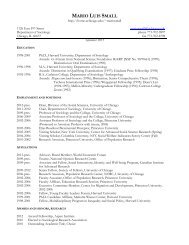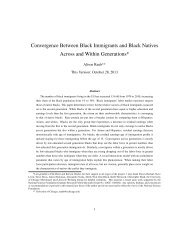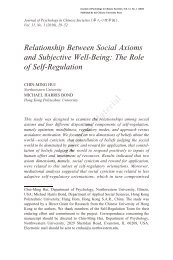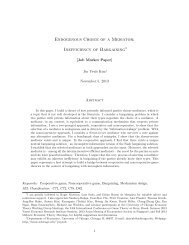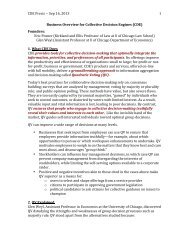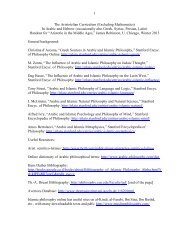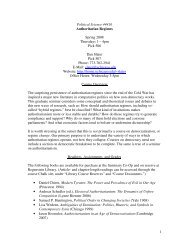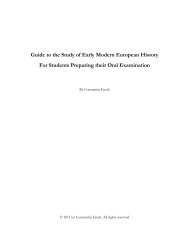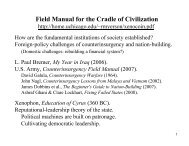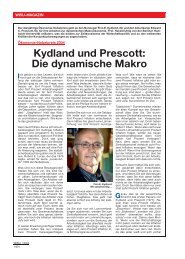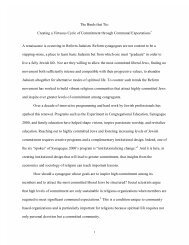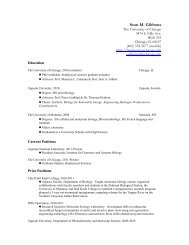Leopold Sedar Senghor Liberte 1:Negritude et Humanisme. On ...
Leopold Sedar Senghor Liberte 1:Negritude et Humanisme. On ...
Leopold Sedar Senghor Liberte 1:Negritude et Humanisme. On ...
You also want an ePaper? Increase the reach of your titles
YUMPU automatically turns print PDFs into web optimized ePapers that Google loves.
Book Reviews<br />
ideas of Teilhard de Chardin, whose writings became central to him after<br />
the mid-1950s.<br />
<strong>Senghor</strong>’s ideas changed slowly but steadily over the course of his life,<br />
since both his habits of thought and his immediate political needs drove<br />
him to focus on present matters. <strong>On</strong>e sees this first of all in his sources. The<br />
early works employ the writings of Leo Frobenius and other European <strong>et</strong>hnographers<br />
to undermine racist descriptions of black “primitivism,” whereas<br />
the later ones engage directly with Marxism as a flawed account of presentday<br />
Africa. The early works derive their tolerant humanism in part from<br />
the attempt of Jacques Maritain (in <strong>Humanisme</strong> Intégral, 1936) to envision<br />
a world soci<strong>et</strong>y in which Catholicism would be but one of several religions,<br />
where the later ones rely heavily on the progressivist evolutionism and scientized<br />
moralism of Pierre Teilhard de Chardin. (It is striking that both writers<br />
were considered dangerous by the Catholic church, to which <strong>Senghor</strong><br />
remained dedicated throughout his life: Maritain’s book was nearly placed<br />
on the Index, and Teilhard de Chardin’s major work was suppressed during<br />
his lif<strong>et</strong>ime by the general of the Jesuit order to which he belonged.)<br />
But the change in <strong>Senghor</strong> involves not only sources, but also ideas. <strong>Senghor</strong>’s<br />
earliest pieces make much of métissage—hybridization. He saw métissage<br />
everywhere—in his father’s combination of native beliefs with Catholicism,<br />
in the Senegalese racial mixture of Berbers and sub-Saharan<br />
Africans, in his own combination of French and Senegalese experience. But<br />
hybridization eventually staled for <strong>Senghor</strong> the politician and writer, however<br />
much it may have described <strong>Senghor</strong> the man. His later work argues<br />
the need for a different African way, less a hybridizing of Western and African<br />
ideas and more a newly envisioned form of socialism, rooted in what <strong>Senghor</strong><br />
took to be the traditional soci<strong>et</strong>y of Africans. The judicious professor,<br />
standing above the fray, had to take sides when he became a politican and<br />
president.<br />
It has been common to belittle <strong>Senghor</strong>’s social theory as having mistaken<br />
the distinction of traditional and modern soci<strong>et</strong>ies for the distinction—correlated<br />
with the first in <strong>Senghor</strong>’s experience—of black and white<br />
soci<strong>et</strong>ies. This is false in two crucial respects. First, <strong>Senghor</strong> was well aware<br />
that not all nonmodern soci<strong>et</strong>ies were black, as one notes from his scattered<br />
remarks about China, the Arab Middle East, North Africa, and India. To<br />
be sure, he never evinces the broadly historical consciousness that typically<br />
sustains a narrative sensibility’s concept of the universal. But that was not<br />
his way. He seeks the universal realities of the colonial encounter through a<br />
profound mastery of his own case, as the lyrical sensibility requires.<br />
But more important, <strong>Senghor</strong> does not think that the virtues of negritude<br />
are either absent from or indeed optional in modern life. Quite the contrary,<br />
for him negritude embodies the direct experiencing of the world that<br />
must be recovered if humanity is to advance. So he identifies the key signs<br />
of negritude in Western writers as diverse as Louise Labé, Victor Hugo, and<br />
even J. W. Go<strong>et</strong>he. Philosophical movements like existentialism and phenom-<br />
303<br />
This content downloaded from 128.135.12.127 on Wed, 13 Nov 2013 17:25:32 PM<br />
All use subject to JSTOR Terms and Conditions



